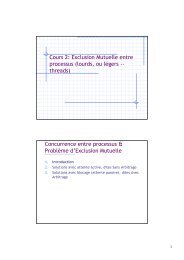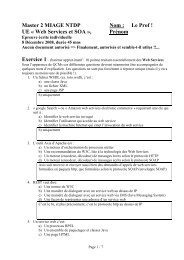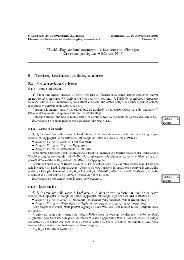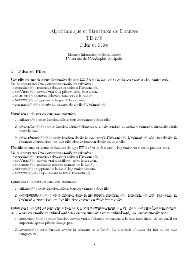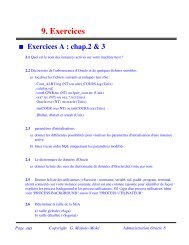Exercices Master Informatique, IFI, Parcours CSSR Course 2 2010 ...
Exercices Master Informatique, IFI, Parcours CSSR Course 2 2010 ...
Exercices Master Informatique, IFI, Parcours CSSR Course 2 2010 ...
You also want an ePaper? Increase the reach of your titles
YUMPU automatically turns print PDFs into web optimized ePapers that Google loves.
od<br />
Release the resource<br />
To request the resource, a process sends a timestamped request to the other process, which<br />
grants the request only if (i) it is not interested in the resource at that moment, or, (ii) its<br />
own timestamp for resource request is larger than the timestamp of the incoming request. In<br />
all other situations, the grant is deferred. After receiving the grant, a process acquires the<br />
resource. Once a process acquires a resource, it guarantees to release the resource within a<br />
finite amount of time. Thereafter, in a finite time, the resource is released.<br />
Can you solve the problem using timestamps of bounded size ? Explain your answer.<br />
(Hint: First find out what is the maximum difference between the timestamps of the two<br />
processes if the timestamps are unbounded. The timestamp of bounded size must resolve the<br />
order of requests without any ambiguity.)<br />
Exercice 4 (adapted from one from Chapter 6 of Ghosh)<br />
In a network of N processes (N>2), all channels are FIFO (and bi-directional), and of infinite<br />
capacity. Every process is required to accept data from the other processes in strictly<br />
increasing order of timestamps. You can assume (i) processes send data infinitely often,<br />
and (ii) no messages is lost in transit.<br />
First, build a 3 processes example, that illustrates this requirement on the following scenario:<br />
Process P1 sends 2 messages, one to P2, one to P3. On reception, P3 sends a new<br />
message to P2. All messages are timestamped using Lamport’s clocks.<br />
Then, propose an implementation to make it possible that processes respect the requirement.<br />
(Hint: Consider using null messages through a channel to signal the absence of a<br />
message from a sender).<br />
Exercice 5 (from Chapter 8, Ghosh)<br />
Construct an example to show that Chandy-Lamport distributed snapshot algorithm does<br />
not work when the channels are not FIFO.<br />
Exercice 6 (from Chapter 11, Coulouris and al. book)<br />
Two processes P and Q are connected in a ring using two-channels, and they constantly rotate<br />
a message m. At any one time, there is only one copy of m in the system. Each process’s<br />
state consists of the number of times it has received m, and P sends m first. At a certain<br />
point, P has the message and its state is 101. Immediately after sending m, P initiates the<br />
snapshot algorithm. Explain the operation of the algorithm in this case giving the global<br />
state reported by it.<br />
4







